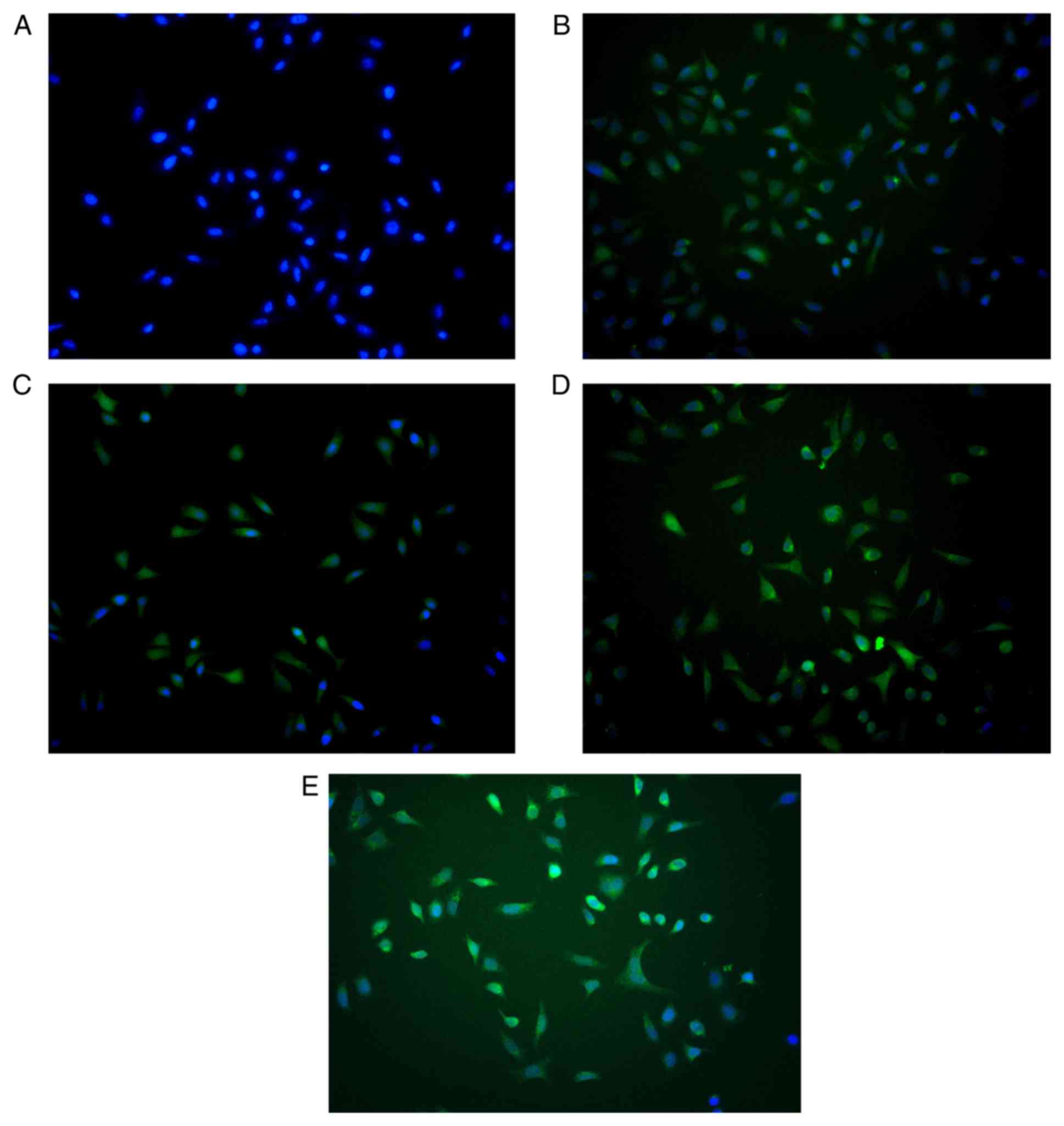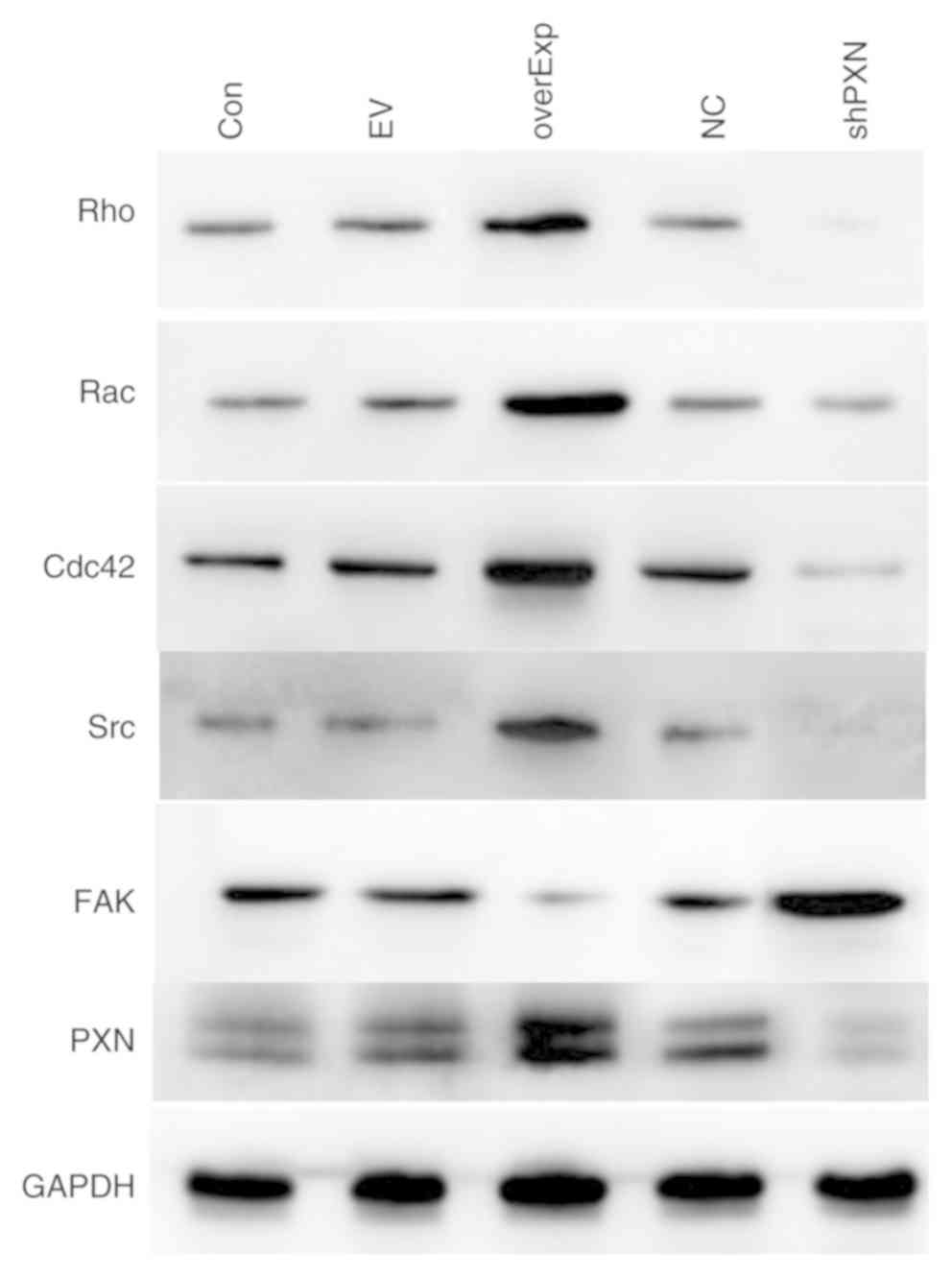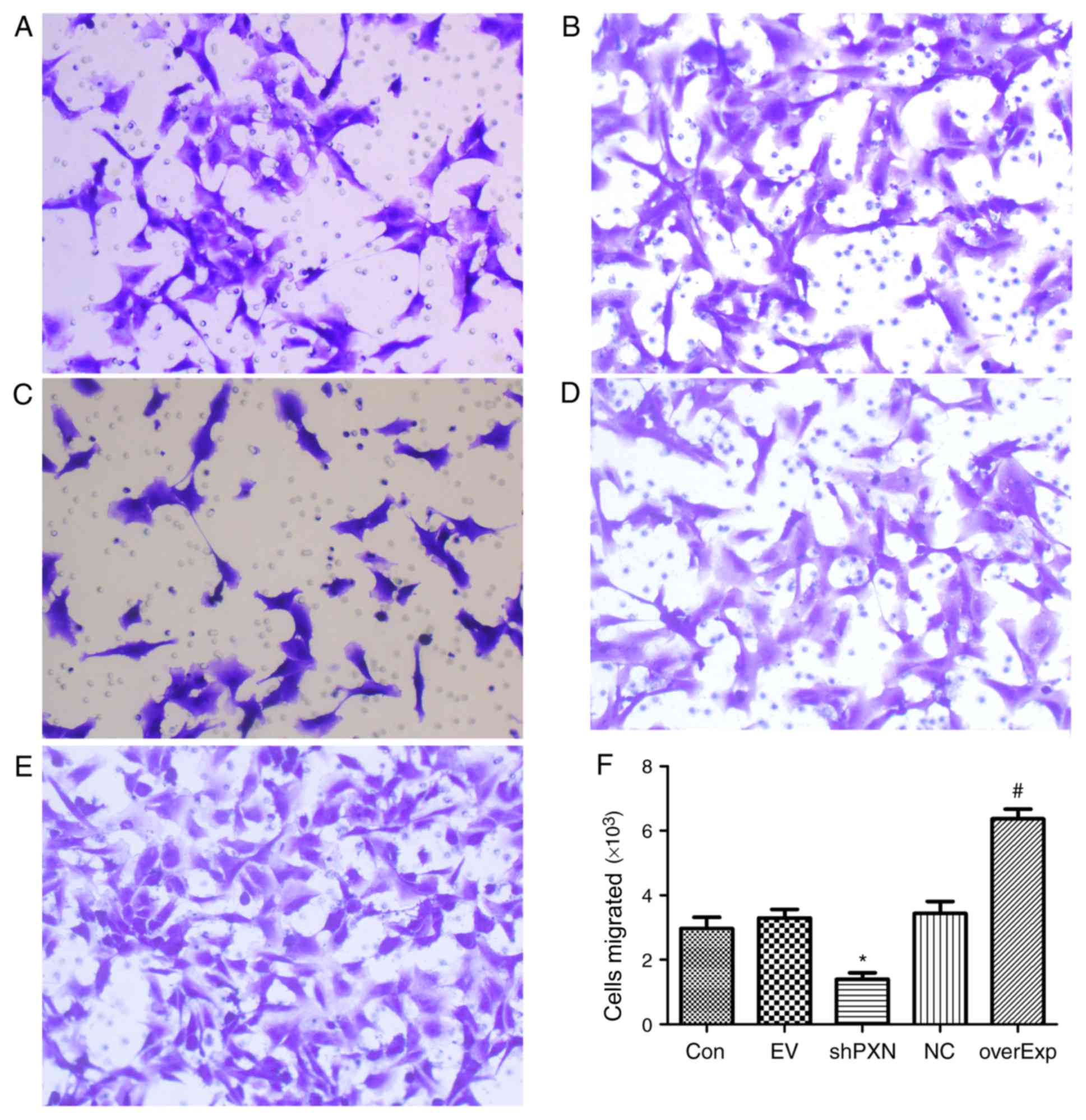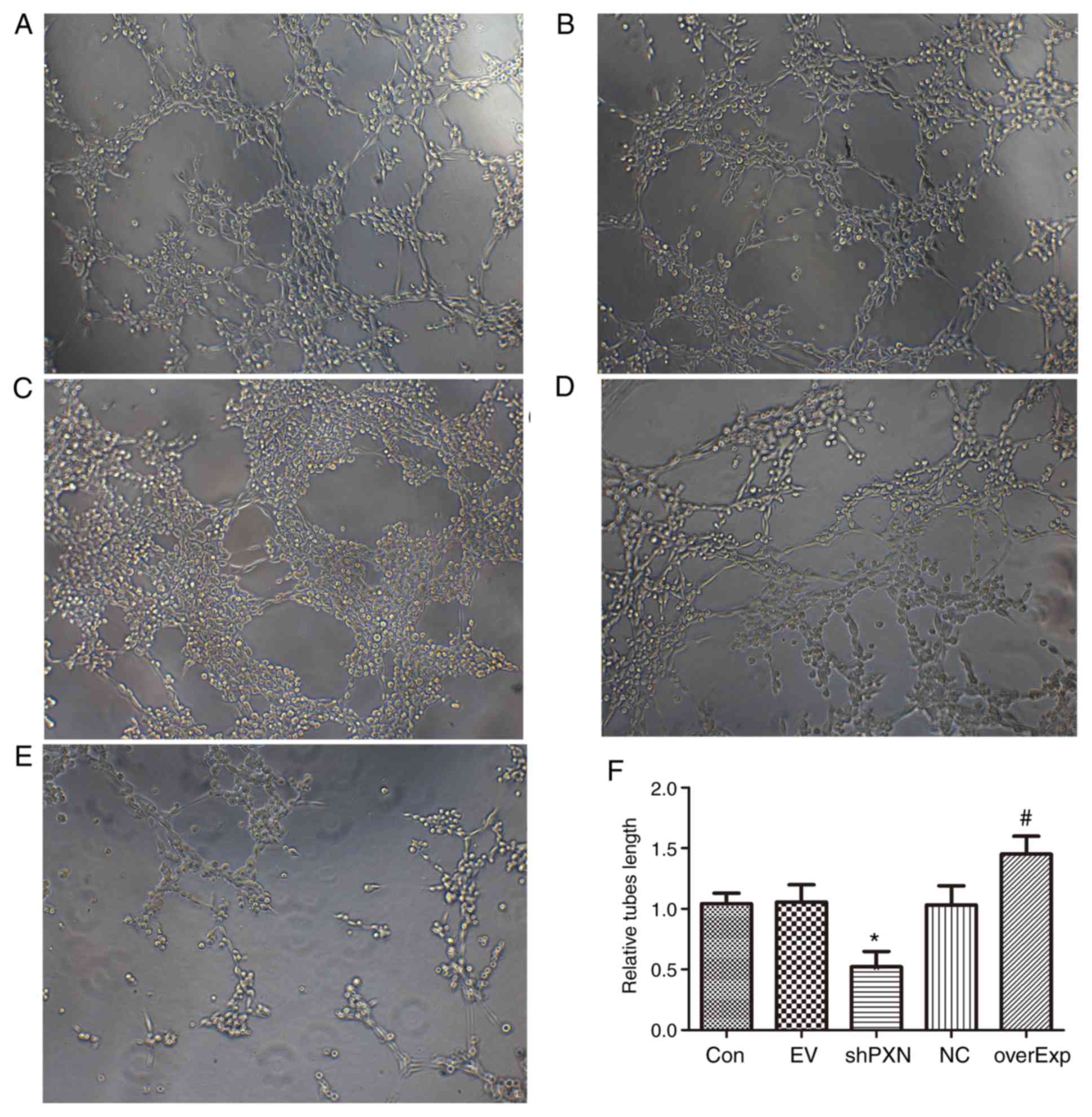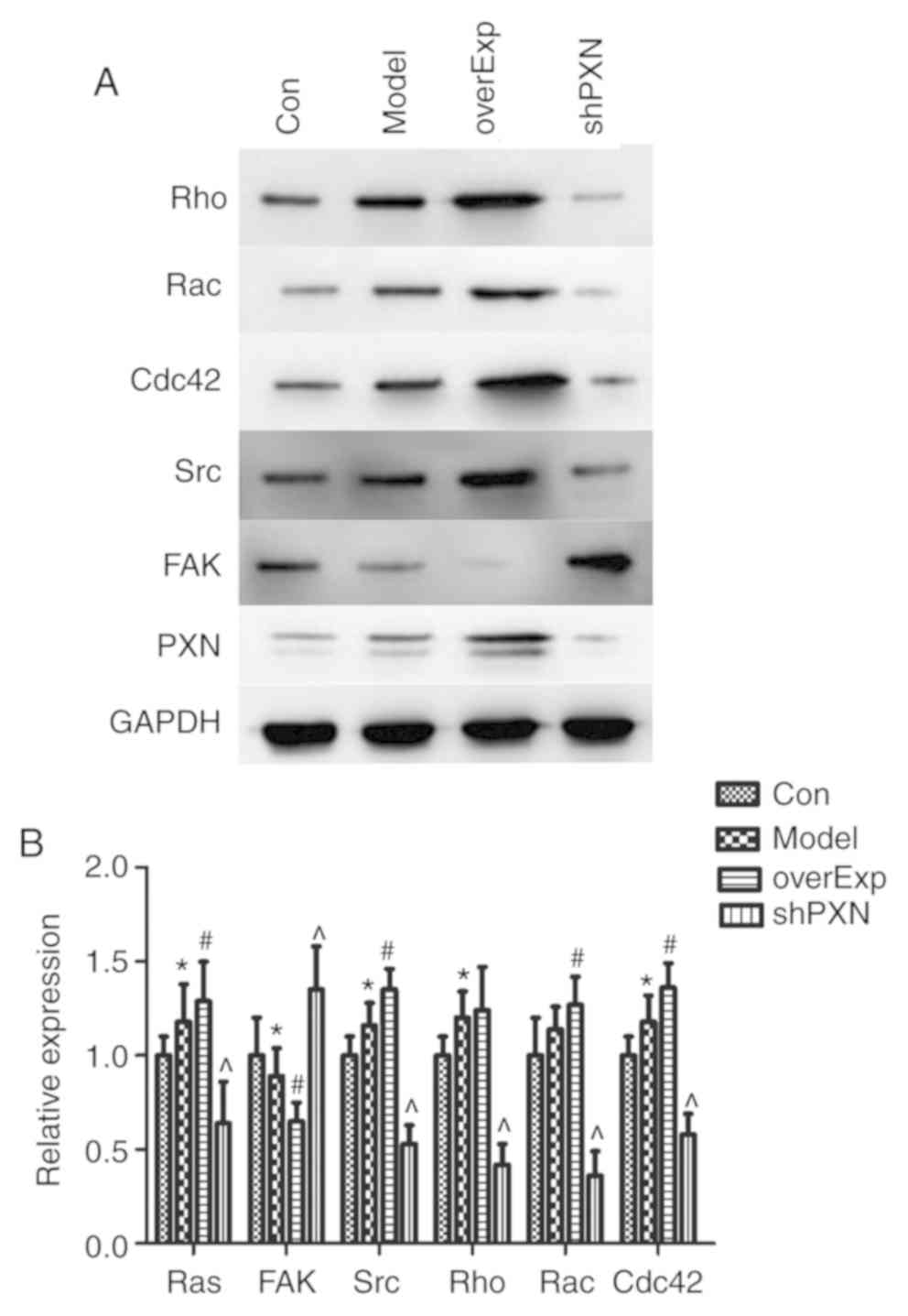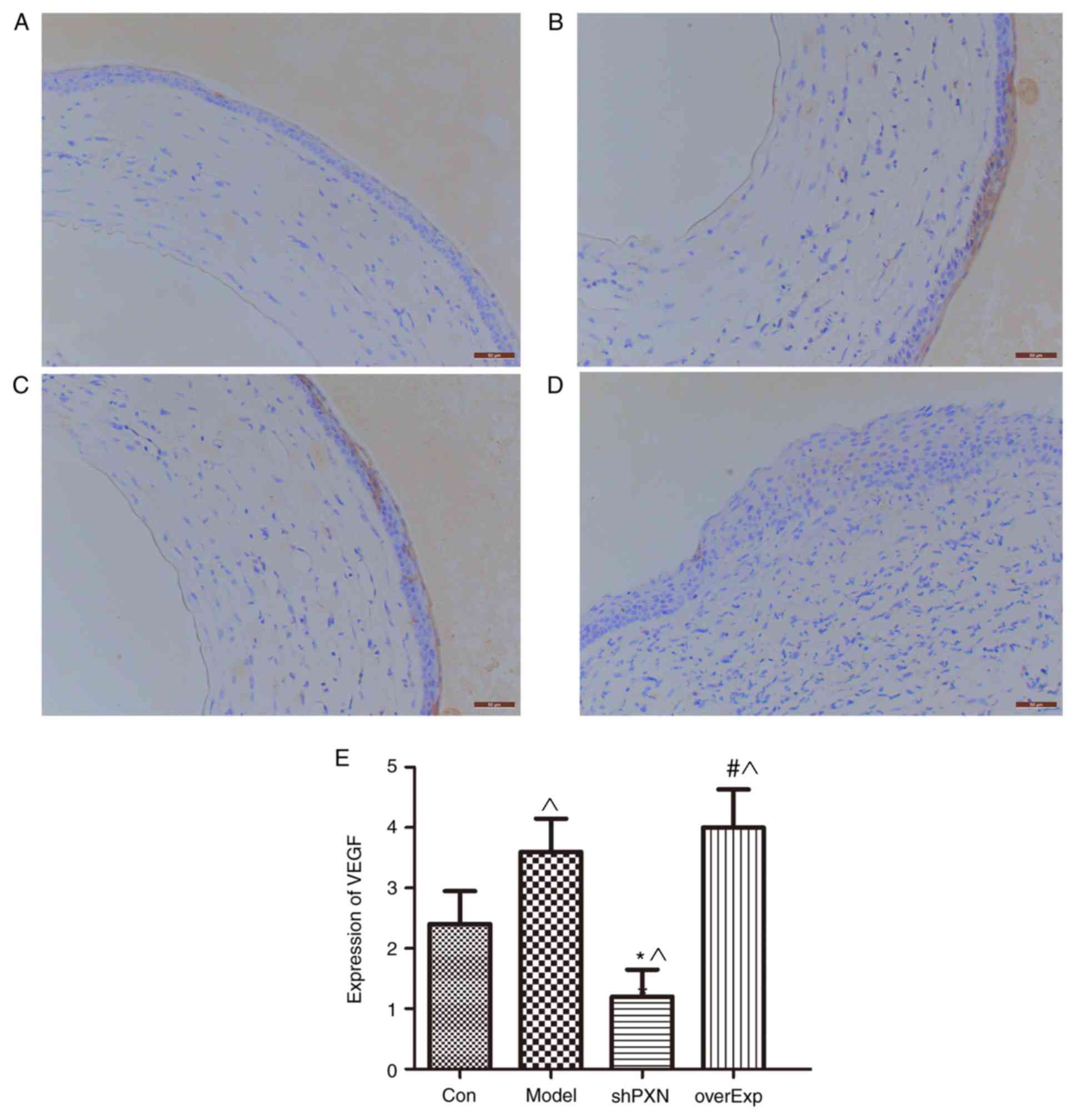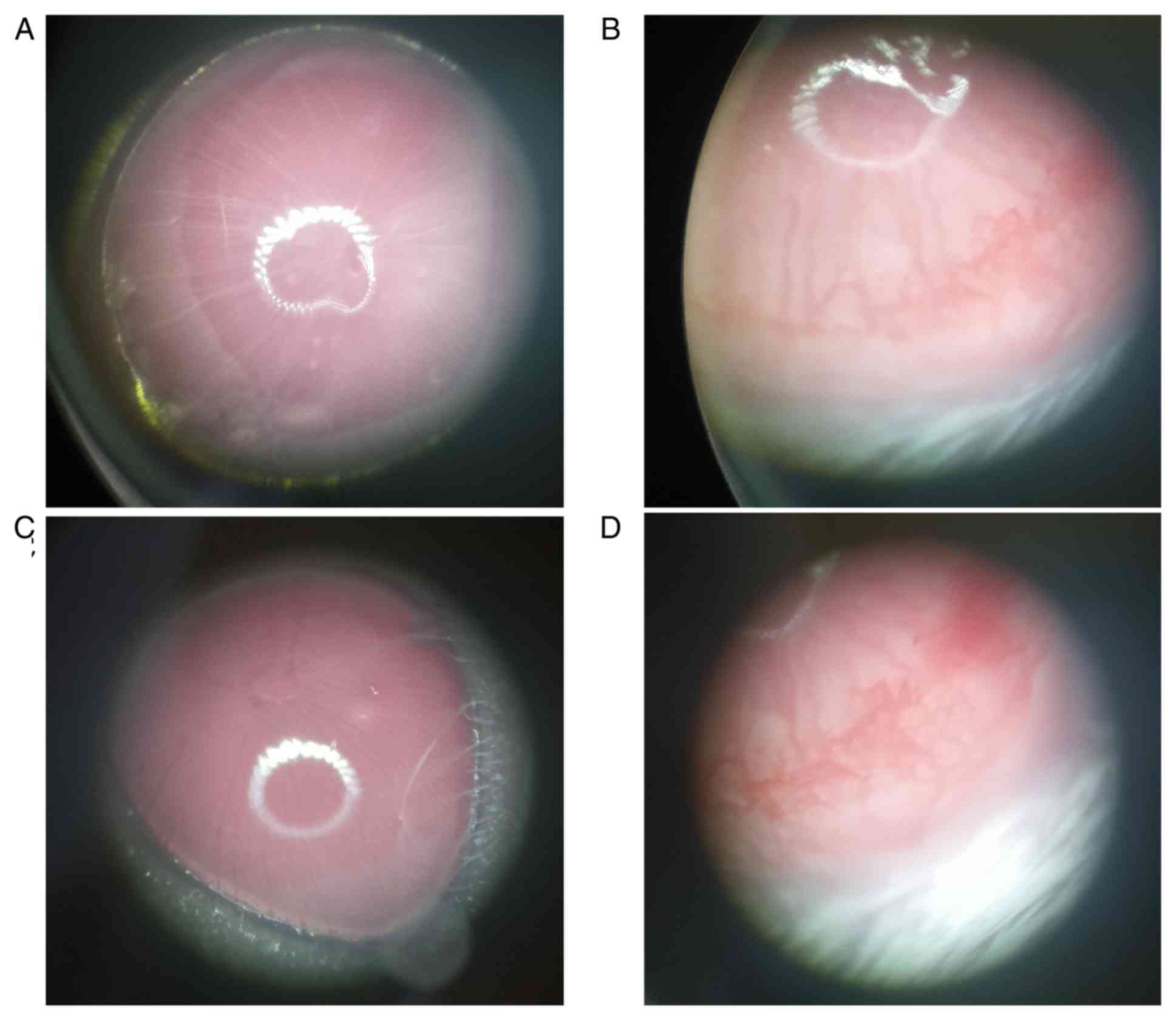|
1
|
Gong X and Rubin LP: Role of macular
xanthophylls in prevention of common neovascular retinopathies:
Retinopathy of prematurity and diabetic retinopathy. Arch Biochem
Biophys. 572:40–48. 2015.PubMed/NCBI View Article : Google Scholar
|
|
2
|
Hackett SF, Seidel C, Abraham S, Chadha R,
Fortmann SD, Campochiaro PA and Cooke JP: The nicotinic cholinergic
pathway contributes to retinal neovascularization in a mouse model
of retinopathy of prematurity. Invest Ophthalmol Vis Sci.
58:1296–1303. 2017.PubMed/NCBI View Article : Google Scholar
|
|
3
|
Choudhry N, Golding J and Rao RC: Vitreous
invasion: Neovascular frond in proliferative diabetic retinopathy.
Ophthalmology. 123(2625)2016.PubMed/NCBI View Article : Google Scholar
|
|
4
|
Nguyen QD, De Falco S, Behar-Cohen F, Lam
WC, Li X, Reichhart N, Ricci F, Pluim J and Li WW: Placental growth
factor and its potential role in diabetic retinopathy and other
ocular neovascular diseases. Acta Ophthalmol. 96:e1–e9.
2018.PubMed/NCBI View Article : Google Scholar
|
|
5
|
Singh NK, Kotla S, Kumar R and Rao GN:
Cyclic AMP response element binding protein mediates pathological
retinal neovascularization via modulating DLL4-NOTCH1 signaling.
EBioMedicine. 2:1767–1784. 2015.PubMed/NCBI View Article : Google Scholar
|
|
6
|
Nakama T, Yoshida S, Ishikawa K, Kubo Y,
Kobayashi Y, Zhou Y, Nakao S, Hisatomi T, Ikeda Y, Takao K, et al:
Therapeutic effect of novel single-stranded RNAi agent targeting
periostin in eyes with retinal neovascularization. Mol Ther Nucleic
Acids. 6:279–289. 2017.PubMed/NCBI View Article : Google Scholar
|
|
7
|
Lisiak N, Paszel-Jaworska A, Toton E,
Rubis B, Pakula M, Bednarczyk-Cwynar B, Zaprutko L and Rybczynska
M: Semisynthetic oleanane triterpenoids inhibit migration and
invasion of human breast cancer cells through downregulated
expression of the ITGB1/PTK2/PXN pathway. Chem Biol Interact.
268:136–147. 2017.PubMed/NCBI View Article : Google Scholar
|
|
8
|
German AE, Mammoto T, Jiang E, Ingber DE
and Mammoto A: Paxillin controls endothelial cell migration and
tumor angiogenesis by altering neuropilin 2 expression. J Cell Sci.
127:1672–1683. 2014.PubMed/NCBI View Article : Google Scholar
|
|
9
|
Yang WJ, Yang YN, Cao J, Man ZH, Li Y and
Xing YQ: Paxillin regulates vascular endothelial growth factor
A-induced in vitro angiogenesis of human umbilical vein
endothelial cells. Mol Med Rep. 11:1784–1792. 2015.PubMed/NCBI View Article : Google Scholar
|
|
10
|
Livak KJ and Schmittgen TD: Analysis of
relative gene expression data using real-time quantitative PCR and
the 2(-Delta Delta C(T)) method. Methods. 25:402–408.
2001.PubMed/NCBI View Article : Google Scholar
|
|
11
|
Watanabe M, Da Fonseca CD and Vattimo Mde
F: Instrumental and ethical aspects of experimental research with
animal models. Rev Esc Enferm USP. 48:181–188. 2014.PubMed/NCBI View Article : Google Scholar
|
|
12
|
Morton DB and Griffiths PH: Guidelines on
the recognition of pain, distress and discomfort in experimental
animals and hypothesis for assessment. Vet Rec. 116:431–436.
1985.PubMed/NCBI View Article : Google Scholar
|
|
13
|
Voiculescu OB, Voinea LM and Alexandrescu
C: Corneal neovascularization and biological therapy. J Med Life.
8:444–448. 2015.PubMed/NCBI
|
|
14
|
Norooznezhad AH, Norooznezhad F and Ahmadi
K: Next target of tranilast: Inhibition of corneal
neovascularization. Med Hypotheses. 82:700–702. 2014.PubMed/NCBI View Article : Google Scholar
|
|
15
|
Hsu CC, Chang HM, Lin TC, Hung KH, Chien
KH, Chen SY, Chen SN and Chen YT: Corneal neovascularization and
contemporary antiangiogenic therapeutics. J Chin Med Assoc.
78:323–330. 2015.PubMed/NCBI View Article : Google Scholar
|
|
16
|
Gupta D and Illingworth C: Treatments for
corneal neovascularization: A review. Cornea. 30:927–938.
2011.PubMed/NCBI View Article : Google Scholar
|
|
17
|
Nikolopoulos SN and Turner CE: Actopaxin,
a new focal adhesion protein that binds paxillin LD motifs and
actin and regulates cell adhesion. J Cell Biol. 151:1435–1448.
2000.PubMed/NCBI View Article : Google Scholar
|
|
18
|
Kratimenos P, Koutroulis I, Marconi D,
Syriopoulou V, Delivoria-Papadopoulos M, Chrousos GP and Theocharis
S: Multi-targeted molecular therapeutic approach in aggressive
neuroblastoma: The effect of Focal Adhesion Kinase-Src-Paxillin
system. Expert Opin Ther Targets. 18:1395–1406. 2014.PubMed/NCBI View Article : Google Scholar
|
|
19
|
Grgurevich S, Mikhael A and Mcvicar DW:
The Csk homologous kinase, Chk, binds tyrosine phosphorylated
Paxillin in Human Blastic T cells. Biochem Biophys Res Commun.
256:668–675. 1999.PubMed/NCBI View Article : Google Scholar
|
|
20
|
Brown MC, Perrotta JA and Turner CE:
Identification of LIM3 as the principal determinant of paxillin
focal adhesion localization and characterization of a novel motif
on paxillin directing vinculin and focal adhesion kinase binding. J
Cell Biol. 135:1109–1123. 1996.PubMed/NCBI View Article : Google Scholar
|
|
21
|
Tsai WC, Yu TY, Lin LP, Lin MS, Tsai TT
and Pang JS: Platelet rich plasma promotes skeletal muscle cell
migration in association with up-regulation of FAK, paxillin, and
F-Actin formation. J Orthop Res. 35:2506–2512. 2017.PubMed/NCBI View Article : Google Scholar
|
|
22
|
Wu KH, Ho CT, Chen ZF, Chen LC, Whang-Peng
J, Lin TN and Ho YS: The apple polyphenol phloretin inhibits breast
cancer cell migration and proliferation via inhibition of signals
by type 2 glucose transporter. J Food Drug Anal. 26:221–231.
2018.PubMed/NCBI View Article : Google Scholar
|
|
23
|
Jagadeeswaran R, Zumba O, Yala S and
Salgia R: Paxillin and MET interactions promote lung cancer growth,
invasion, and angiogenesis. Cancer Res: 68, 2008.
|
|
24
|
Lyck R, Reiss Y, Gerwin N, Greenwood J,
Adamson P and Engelhardt B: T-cell interaction with ICAM-1/ICAM-2
double-deficient brain endothelium in vitro: The cytoplasmic tail
of endothelial ICAM-1 is necessary for transendothelial migration
of T cells. Blood. 102:3675–3683. 2003.PubMed/NCBI View Article : Google Scholar
|
|
25
|
Stiegler AL, Draheim KM, Li X, Chayen NE,
Calderwood DA and Boggon TJ: Structural basis for paxillin binding
and focal adhesion targeting of β-parvin. J Biol Chem.
287:32566–32577. 2012.PubMed/NCBI View Article : Google Scholar
|
|
26
|
Turner CE: Paxillin and focal adhesion
signalling. Nat Cell Biol. 2:E231–E236. 2000.PubMed/NCBI View
Article : Google Scholar
|
|
27
|
Minamiguchi K, Kumagai H, Masuda T, Kawada
M, Ishizuka M and Takeuchi T: Thiolutin, an inhibitor of HUVEC
adhesion to vitronectin, reduces paxillin in HUVECs and suppresses
tumor cell-induced angiogenesis. Int J Cancer. 93:307–316.
2001.PubMed/NCBI View
Article : Google Scholar
|
|
28
|
Sero JE, German AE, Mammoto A and Ingber
DE: Paxillin controls directional cell motility in response to
physical cues. Cell Adh Migr. 6:502–508. 2012.PubMed/NCBI View Article : Google Scholar
|
|
29
|
Sero JE, Thodeti CK, Mammoto A, Bakal C,
Thomas S and Ingber DE: Paxillin mediates sensing of physical cues
and regulates directional cell motility by controlling lamellipodia
positioning. PLoS One. 6(e28303)2011.PubMed/NCBI View Article : Google Scholar
|
|
30
|
Lampugnani MG and Dejana E: Adherens
junctions in endothelial cells regulate vessel maintenance and
angiogenesis. Thromb Res. 120 (Suppl 2):S1–S6. 2007.PubMed/NCBI View Article : Google Scholar
|
|
31
|
De Souza Junior DA, Mazucato VM, Santana
AC, Oliver C and Jamur MC: Mast cells interact with endothelial
cells to accelerate in vitro angiogenesis. Int J Mol Sci.
18:2674–2679. 2017.PubMed/NCBI View Article : Google Scholar
|
|
32
|
Ridley AJ, Allen WE, Peppelenbosch M and
Jones GE: Rho family proteins and cell migration. Biochem Soc Symp.
65:111–123. 1999.PubMed/NCBI
|
|
33
|
Krause-Gruszczynska M, Rohde M, Hartig R,
Genth H, Schmidt G, Keo T, Konig W, Miller WG, Konkel ME, Konkel ME
and Backert S: Role of the small Rho GTPases Rac1 and Cdc42 in host
cell invasion of Campylobacter jejuni. Cell Microbiol. 9:2431–2444.
2007.PubMed/NCBI View Article : Google Scholar
|
|
34
|
Hernández-Garcia R, Iruela-Arispe ML,
Reyes-Cruz G and Vazquez-Prado J: Endothelial RhoGEFs: A systematic
analysis of their expression profiles in VEGF-stimulated and tumor
endothelial cells. Vascul Pharmacol. 74:60–72. 2015.PubMed/NCBI View Article : Google Scholar
|
|
35
|
Kusuhara S, Fukushima Y, Fukuhara S, Jakt
LM, Okada M, Shimizu Y, Hata M, Nishida K, Negi A, Hirashima M, et
al: Arhgef15 promotes retinal angiogenesis by mediating
VEGF-induced Cdc42 activation and potentiating RhoJ inactivation in
endothelial cells. PLoS One. 7(e45858)2012.PubMed/NCBI View Article : Google Scholar
|
|
36
|
Nobes CD and Hall A: Rho, rac, and cdc42
GTPases regulate the assembly of multimolecular focal complexes
associated with actin stress fibers, lamellipodia, and filopodia.
Cell. 81:53–62. 1995.PubMed/NCBI View Article : Google Scholar
|
|
37
|
Nakashima M and Lazo JS: Phosphatase of
regenerating liver-1 promotes cell migration and invasion and
regulates filamentous actin dynamics. J Pharmacol Exp Ther.
334:627–633. 2010.PubMed/NCBI View Article : Google Scholar
|
|
38
|
Brzeska H, Szczepanowska J, Matsumura F
and Korn ED: Rac-induced increase of phosphorylation of myosin
regulatory light chain in HeLa cells. Cell Motil Cytoskeleton.
58:186–199. 2010.PubMed/NCBI View Article : Google Scholar
|
|
39
|
Bayless KJ and Davis GE: The Cdc42 and
Rac1 GTPases are required for capillary lumen formation in
three-dimensional extracellular matrices. J Cell Sci.
115:1123–1136. 2002.PubMed/NCBI
|
|
40
|
Vindis C, Teli T, Cerretti DP, Turner CE
and Huynh-Do U: EphB1-mediated cell migration requires the
phosphorylation of paxillin at Tyr-31/Tyr-118. J Biol Chem.
279:27965–27970. 2004.PubMed/NCBI View Article : Google Scholar
|
|
41
|
Sachdev S, Bu Y and Gelman IH:
Paxillin-Y118 phosphorylation contributes to the control of
Src-induced anchorage-independent growth by FAK and adhesion. BMC
Cancer. 9(12)2009.PubMed/NCBI View Article : Google Scholar
|















